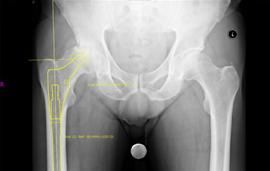Radiography for Joint Replacement Using Calibration Markers

When radiologic technologists are using digital systems to capture images that were ordered by orthopedic surgeons for joint replacement surgery, magnification needs to be considered. There are some specific tools and techniques necessary for this.
In the olden days of plain film, orthopedic surgeons planned these surgeries using cut out templates of orthopedic implant hardware by manually placing them over hard-copy films. The arrival of digital x-ray and PACS has made this job much easier. ( for the surgeon that is). Digital hardware templates can now be superimposed directly into images on a workstation. However, what this means for the radiologic technologist is that there is an additional step to the process. Digital images today don’t always have a physical reference to accurately and consistently communicate the magnification of the bone to the templating software. And magnification is an issue. For example, pelvic x-rays used for planning hip replacements vary in magnification, sometimes from 115% to-130%. This degree of variation occurs partly because of differences in techniques but mainly due to patients’ body habitus. The hip joint of a thin patient lying on an x-ray cassette is only a few centimeters above the image receptor giving little distance for the x-rays to diverge. In an overweight patient, the hip joint can be twice as far from the plate, allowing the divergent beam to spread more before it hits the image receptor.
The solution to this problem is to introduce an object of known size into the plane we are interested in measuring. When using 3d orthopedic template software in this situation it is possible to draw a circle around the marker’s silhouette on the image and enter the diameter. The software then scales the image so that we can take measurements on the x-ray with confidence that they are accurate. For this to happen though, the radiographer has to place a marker at the time of taking the image. The marker is placed on the patient in the plane of the joint.
Types of Orthopedic Scaling Markers
There are various types of markers that can be used by x-ray techs when imaging for joint replacement. If the patient has already had a hip replacement on the other side, the metal femoral head can serve as a scaling marker, but check with the surgeon before making the assumption that this will work for them. Markers of many shapes and sizes have been used. Radio-opaque rulers have been used but they need to be placed in the plane of the hip joint and also held perpendicular to the x-ray beam. The advantage of rulers is that a scale of 50, 100 or even 150mm can be used which reduces error. The disadvantage is fixing and ensuring the ruler stays in the correct position while the image is taken. Metal spheres can be used. The main advantage is that orientation is not important as they are entirely symmetrical. The disadvantage is that spheres can be quite heavy and difficult to hold in the correct plane, even using adhesive strips to hold them. Spheres mounted on adjustable ‘arms’ and attached to a stand with suction cups are available and make it much easier to position the marker correctly.
 A coin or disc makes a very good marker, creating an elliptical shadow on the x-ray. The maximum diameter of the ellipse is always the diameter of the disc, whatever orientation it is lying at. The main advantage of a disc is that it is light and easy to handle even when quite large and can easily be introduced into the correct plane. All these markers can be measured using specially developed scaling tools.
A coin or disc makes a very good marker, creating an elliptical shadow on the x-ray. The maximum diameter of the ellipse is always the diameter of the disc, whatever orientation it is lying at. The main advantage of a disc is that it is light and easy to handle even when quite large and can easily be introduced into the correct plane. All these markers can be measured using specially developed scaling tools.
Radiographic Positioning for Joint Replacement
As always, the x-ray tech should collimate to avoid unnecessary exposure. However, when imaging for joint replacement, it’s necessary for the x-ray tech to include several inches of the long bones on either side of the joint. This is because the implants will go 2 or 3 inches into these bones, sometimes more, and the surgeon will need to see that much of the anatomy to assess for implants. It’s also necessary, obviously, to include the marker which is outside of the body.
As can be expected, some surgeons may require alternative positioning according to their particular requirements. The devices shown in these illustrations can be replaced with alternative objects of known size as discussed previously. Also, all objects used in a patient contact environment will need to be cleaned according to the local health and safety hygiene requirements with a suitable cleaning solution after each use.
Hip and Pelvis Radiographic Positioning with Markers
When a radiologic technologist takes a radiograph of the hip for joint replacement, the image should include the upper third of the femoral shaft. When using a sphere with an arm and suction cup or stand, you will first need to adjust the arm so that the ball is the same distance from the image receptor as the greater trochanter.
When placing a scaling marker for hip x-rays, the greater trochanter provides a good palpable bone landmark in the plane of the hip joint. Positioning the marker on the skin over the greater trochanter should work well if this can be accommodated. However, often orthopedists like to have a whole pelvic view for templating hips so that leg length inequality can be recognized and also because it is often helpful to template the comparison side. If a pelvic view is taken, a 14 x 17 field is often barely large enough to include the bones and often miss the soft tissues overlying the greater trochanters. So in some cases, the marker will need to be positioned between the thighs. To do this, first, position the sphere at the level of the greater trochanter on the lateral side of the pelvis, equivalent to the hip joint level. This is to adjust the arm so that the sphere is the correct height. Then, move the marker carefully without changing the shape of the arm, to the same vertical height level between the thighs where it will be visible in the radiation field.


For a lateral oblique Hip, the idea is to show the femoral stem width rather than the hip cup which can be measured in the AP. For this the marker should be placed laterally mid thigh at the level of the femoral shaft. For very large patients any adipose tissue will need to be taken into account.



For a lateral inferior-superior neck of femur view, the marker is positioned anteriorly mid-thigh to establish femoral canal width. Remember that the goal is to have the marker the same distance from the image receptor as the bone of interest.
Knee and Femur Radiographic Positioning with Markers
When imaging for a knee replacement, the radiographer should position the patient so that a good amount of the femoral and tibial shafts are visible on the image. For an AP view of the knee, the marker should be placed over the lateral side of the knee in the joint line, roughly midway between anterior and posterior surfaces. If a patient has large leg muscles or is obese, this needs to be considered. Remember that the goal is to have the marker the same distance from the image receptor as the joint. For an AP View of the femur, place the marker midway between anterior and posterior surfaces of the body part, over the shaft of the bone on the lateral side.


For a mediolateral view of the knee, the marker should be placed on the anterior side of the knee, either superior or inferior to patella in the midline. For a mediolateral view of the femur, place the marker on the anterior part of the limb in the midline.For a lateromedial view, place the marker on the anterior mid-line of the limb around the area of interest. The surgeon needs to know if the view is a lateromedial or mediolateral, so best practice is to annotate with a marker if possible.


Shoulder and Humerus Radiographic Positioning with Markers
For an AP Shoulder radiograph for joint replacement, we are looking at the humeral head. The marker should be placed on the lateral side of the humeral head half way between the palpable anterior and posterior bony prominences of the acromion. For an AP view of the humeral shaft, the marker should be placed on the lateral part of the upper arm half way between the anterior and posterior side. For a lateral view, the marker should be placed on the posterior side of the upper arm half way between the lateral and medial surfaces of the limb.




Spine Radiographic Positioning with Markers
For an AP x-ray of the C-Spine, place the marker on the lateral side of the neck over the midpoint between the anterior and posterior aspects of the neck. For a lateral C-Spine, place the marker over the cervical spinous processes on the posterior aspect of the neck. For T and L Spine lateral, place the marker over the spinous processes at the appropriate spinal level. An AP coned view of the spine does not allow marker placement. For full length spine scoliosis images, however, a marker can be placed on the lateral abdomen at spinal level of interest. Some doctors will prefer to use a ruler device.




Image source, Orthoview
Video Credit : Materialise Medical
Visit here to know more information about radiographic positioning and related anatomy.
